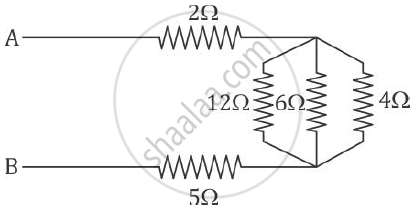Advertisements
Advertisements
प्रश्न
A p.d. of 4 V is applied to two resistors of 6 Ω and 2 Ω connected in series. Calculate:
(a) the combined resistance
(b) the current flowing
(c) the p.d. across the 6 Ω resistor
उत्तर
(a) When two resistors are connected in series, their resultant resistance is given by
R = R1+ R2
Here, R1=6Ω ,
R2=2 Ω
Therefore
The resulatant resistance, R = 6 + 2 = 8 Ω
(b) The current flowing through circuit is:
V = IR
I = V/R = 4/8
I = 0.5 A
(c) The p.d. across the 6 Ω resistor is:
V = 0.5 A x 6 Ω = 3 V
APPEARS IN
संबंधित प्रश्न
Judge the equivalent resistance when the following are connected in parallel − (a) 1 Ω and 106Ω, (b) 1 Ω and 103Ω and 106Ω.
Find the equivalent resistance between points A and B.

Find the equivalent resistance between A and B

Name the material which is the best conductor of electricity.
Calculate the resistance of an aluminium cable of length 10 km and diameter 2.0 mm if the resistivity of aluminium is 27 × 10−8 Ωm.
The diagram below shows part of a circuit:

If this arrangement of three resistors was to be replaced by a single resistor, its resistance should be:
(a) 9 Ω
(b) 4 Ω
(c) 6 Ω
(d) 18 Ω
State the effect of rise in temperature on the resistance of semi-conductors.
Six equal resistors of 1 ohm each are connected to form the sides of a hexagon ABCDEF. Calculate the resistance offered by the combination if the current enters at A and leaves it at D.
Illustrate-combination of cells e.g., three cells, in series, explaining the combination briefly. Obtain an expression for current ‘i’ in the combination.
Consider the following combinations of resistors:




The combinations having equivalent resistance 1 Q is/are ______.
